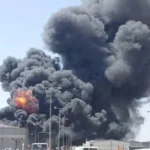In a devastating turn of events, the capital of the Democratic Republic of the Congo (DRC), Kinshasa, recently faced a natural disaster that resulted in the loss of dozens of lives. Since the onset of torrential rains in early October 2023, the city has been grappling with severe flooding, as streets turned into raging rivers, and areas submerged under murky waters. This disaster has highlighted not only the vulnerability of urban infrastructure but also the urgent need for improved disaster preparedness in the region.
The heavy rainfall, recording as much as 180 millimeters (7 inches) in just a few days, overwhelmed the city’s drainage systems, which were already ill-equipped to handle such an onslaught. The Congolese government reported that at least 50 people died due to drowning, electrocution, and collapsing buildings, exacerbated by the relentless storm. The flooding devastated entire neighborhoods, tragically displacing thousands of residents and leaving them vulnerable to further health risks, including waterborne diseases.
Local authorities reported that numerous families were trapped in their homes, unable to escape as the floodwaters surged around them. Rescuers worked tirelessly, though their efforts were hampered by the depth of the water and the debris-laden streets. Eyewitness accounts painted a harrowing picture of chaos—people clinging to trees, the frantic cries for help, and the heart-wrenching loss as emergency services struggled to reach those in distress.
The humanitarian impact of the flooding has been immense. The country, already facing significant challenges in terms of health and infrastructure, finds itself in a precarious situation. The Ministry of Health has warned of potential disease outbreaks due to unsanitary conditions in the aftermath of the flooding. With sanitation systems overwhelmed and clean drinking water sources compromised, public health officials are preparing for an increase in cholera and other waterborne illnesses.
Kinshasa’s urban planners have been criticized for their failure to address the city’s aging infrastructure. Drains and waterways have long been clogged and poorly maintained, making the population particularly susceptible to such disasters. Rapid urbanization in recent years has also exacerbated this vulnerability, as informal settlements have sprung up in flood-prone areas without adequate planning or resources.
Despite the tragedy, the floods have revived discussions about climate change and environmental degradation in the DRC. Experts warn that extreme weather events, including heavy rainfall and flooding, are becoming more frequent due to the changing climate. Kinshasa, with a growing population and extensive deforestation in surrounding areas, faces an uphill battle. Sustainable urban planning, reforestation efforts, and improved infrastructure are critical to mitigate the risks posed by future extreme weather events.
In response to this disaster, officials are calling for international assistance. The United Nations and various non-governmental organizations (NGOs) are mobilizing to provide medical aid, shelter, and food resources to the affected populations. The international community is urged to step up support, both in the immediate relief efforts and in long-term strategies to enhance urban resilience in Kinshasa.
As Kinshasa begins to assess the extent of the damage and mourns the significant loss of life, it serves as a poignant reminder of the consequences of climate change and the importance of effective disaster management. The hope is that this tragedy will lead to a renewed commitment to infrastructure development and environmental sustainability to protect the vulnerable populations of Kinshasa from future calamities. The people of Kinshasa are resilient, but they will need robust support to recover and rebuild from this devastating disaster.
Email Us on editorial@nnafrica.com













